Three-Dimensional Analysis of Load Transfer Mechanism for Deep Cement Mixing Piled Embankment under Static and Cyclic Load
Abstract
:1. Introduction
2. Selected Case Study
2.1. General Project Information
2.2. Site Conditions and Instruments
3. Numerical Modeling
3.1. Introduction to the Numerical Model and the Calculation Method
3.2. Boundary Conditions and Applied Load
3.3. Finite-Element Mesh Details
3.4. Verification and Validation of the Numerical Model
3.5. Comparison between DCM Piled Foundation and Rigid Piled Foundation
4. Parametric Studies Results and Discussion
4.1. Influences of Elastic Modulus of DCM Piles
4.2. Influence of the Length of DCM Piles
4.3. Influence of the Area Replacement Ratio
4.4. Influences of Embankment Height
4.5. Influences of Vehicle Speeds
5. Modification of the Stress Reduction Ratio (SRR) Based on the Numerical Results
6. Conclusions
- (1)
- The difference in the working performance between the DCM piled and rigid piled embankment was observed. The effect of soil arching was greatly reduced in the DCM piled embankment. This induced approximately 61.5% more vertical stress transferred to the subsoil surface and approximately 83–150% more settlement of the embankment in the DCM piled foundation system.
- (2)
- The variation law of the embankment settlement: Macroscopically, increasing the elastic modulus of DCM piles, the length of DCM piles, the area replacement ratio, and reducing the embankment height can decrease the settlement of the embankment. The area replacement ratio is found to be the most influential factor affecting the embankment settlement.
- (3)
- Load transfer efficacy: The rise in the elastic modulus of the DCM piles, the length of the DCM piles, the area replacement ratio, and embankment height will increase the load transfer efficacy. The elastic modulus of the DCM pile emerges as the most influential factor affecting the distribution and magnitude of the vertical stress and the maximum earth pressure coefficient, followed by embankment height and area replacement ratio, and the length of DCM piles have a slight effect on the load transfer efficacy.
- (4)
- The effect of soil arching is reduced when the embankment is subjected to cyclic loads. A cyclic load with the vehicle speed of 90 km/h will lead to an approximately 34% increase in embankment settlement and an approximately 11% reduction in the maximum earth pressure coefficient.
- (5)
- The stress reduction ratio for DCM piled foundations was proposed and validated by two field cases, with differences in the range of 13.8~16.7%. Therefore, the proposed equation can provide a reliable evaluation on the vertical stress at the surface of the subsoil for DCM piled foundations with reasonable accuracy.
Author Contributions
Funding
Institutional Review Board Statement
Informed Consent Statement
Data Availability Statement
Conflicts of Interest
References
- Yapage, N.N.S.; Liyanapathirana, D.S.; Kelly, R.B.; Poulos, H.G.; Leo, C.J. Numerical modeling of an embankment over soft ground improved with deep cement mixed columns: Case history. J. Geotech. Geoenviron. Eng. 2014, 140, 04014062. [Google Scholar] [CrossRef]
- Zhuang, Y.; Wang, K.Y. Numerical simulation of high-speed railway foundation improved by PVD-DCM method and compared with field measurements. Eur. J. Environ. Civ. Eng. 2017, 21, 1363–1383. [Google Scholar] [CrossRef]
- Han, J.; Oztoprak, S.; Parsons, R.L.; Huang, J. Numerical analysis of foundation columns to support widening of embankments. Comput. Geotech. 2007, 34, 435–448. [Google Scholar] [CrossRef]
- Liu, S.Y.; Du, Y.J.; Yi, Y.L.; Puppala, A.J. Field investigations on performance of T-shaped deep mixed soil cement column-supported embankments over soft ground. J. Geotech. Geoenviron. Eng. 2012, 138, 718–727. [Google Scholar] [CrossRef]
- Terashi, M.; Ooya, T.; Fujita, T.; Okami, T.; Yokoi, K.; Shinkawa, N. Specifications of Japanese dry methods of deep mixing deduced from 4300 projects on land. In Proceedings of the International Symposium on Deep Mixing & Admixture Stabilization, Okinawa, Japan, 19 May 2009; pp. 647–652. [Google Scholar]
- Jamsawang, P.; Yoobanpot, N.; Thanasisathit, N.; Voottipruex, P.; Jongpradist, P. Three-dimensional numerical analysis of a DCM column-supported highway embankment. Comput. Geotech. 2016, 72, 42–56. [Google Scholar] [CrossRef]
- Voottipruex, P.; Bergado, D.T.; Suksawat, T.; Jamsawang, P.; Cheang, W. Behavior and simulation of deep cement mixing (DCM) and stiffened deep cement mixing (SDCM) piles under full scale loading. Soils Found. 2011, 51, 307–320. [Google Scholar] [CrossRef] [Green Version]
- Jiang, Y.; Han, J.; Zheng, G. Numerical analysis of consolidation of soft soils fully-penetrated by deep-mixed columns. KSCE J. Civ. Eng. 2013, 17, 96–105. [Google Scholar] [CrossRef]
- Jamsawang, P.; Voottipruex, P.; Boathong, P.; Mairaing, W.; Horpibulsuk, S. Three-dimensional numerical investigation on lateral movement and factor of safety of slopes stabilized with deep cement mixing column rows. Eng. Geol. 2015, 188, 159–167. [Google Scholar] [CrossRef]
- Yi, Y.L.; Liu, S.Y.; Puppala, A.J.; Xi, P.S. Vertical bearing capacity behaviour of single T-shaped soil-cement column in soft ground: Laboratory modelling, field test, and calculation. Acta Geotech. 2017, 12, 1077–1088. [Google Scholar] [CrossRef]
- Phutthananon, C.; Jongpradist, P.; Yensri, P.; Jamsawang, P. Dependence of ultimate bearing capacity and failure behavior of T-shaped deep cement mixing piles on enlarged cap shape and pile strength. Comput. Geotech. 2018, 97, 27–41. [Google Scholar] [CrossRef]
- Phutthananon, C.; Jongpradist, P.; Jongpradist, P.; Dias, D.; Baroth, J. Parametric analysis and optimization of T-shaped and conventional deep cement mixing column-supported embankments. Comput. Geotech. 2020, 122, 103555. [Google Scholar] [CrossRef]
- Hewlett, W.J.; Randolph, M.F. Analysis of piled embankments. Ground Eng. 1988, 21, 12–18. [Google Scholar]
- Zhang, L.; Zhao, M.H.; Hu, Y.X.; Zhao, H.; Chen, B.C. Semi-analytical solutions for geosynthetic-reinforced and pile-supported embankment. Comput. Geotech. 2012, 44, 167–175. [Google Scholar] [CrossRef]
- Van Eekelen, S.J.M.; Bezuijen, A.; Van Tol, A.F. An analytical model for arching in piled embankments. Geotext. Geomembr. 2013, 39, 78–102. [Google Scholar] [CrossRef]
- Zhuang, Y.; Wang, K.Y.; Liu, H.L. A simplified model to analyze the reinforced piled embankments. Geotext. Geomembr. 2014, 42, 154–165. [Google Scholar] [CrossRef]
- Nguyen, V.D.; Luo, Q.; Wang, T.F.; Liu, K.F.; Zhang, L.; Nguyen, T.P. Load transfer in geosynthetic-reinforced piled embankments with a triangular arrangement of piles. J. Geotech. Geoenviron. Eng. 2023, 149, 04022131. [Google Scholar] [CrossRef]
- Indraratna, B.; Basack, S.; Rujikiatkamjorn, C. Numerical solution of stone column–improved soft soil considering arching, clogging, and smear effects. J. Geotech. Geoenviron. Eng. 2013, 139, 377–394. [Google Scholar] [CrossRef] [Green Version]
- Liu, K.W.; Rowe, R.K. Numerical study of the effects of geosynthetic rein-forcement viscosity on behaviour of embankments supported by deep-mixing method columns. Geotext. Geomembr. 2015, 43, 567–578. [Google Scholar] [CrossRef]
- Wang, X.; Wang, X.; Yang, G.; Zong, Y. Study on Load Transfer Mechanism of Pile-Supported Embankment Based on Response Surface Method. Appl. Sci. 2022, 12, 4905. [Google Scholar] [CrossRef]
- Liu, H.L.; Ng, C.W.W.; Fei, K. Performance of a geogrid-reinforced and pile-supported highway embankment over soft clay: Case study. J. Geotech. Geoenviron. Eng. 2007, 113, 1483–1493. [Google Scholar] [CrossRef]
- Nunez, M.A.; Briançon, L.; Dias, D. Analyses of a pile-supported embankment over soft clay: Full-scale experiment, analytical and numerical approaches. Eng. Geol. 2013, 153, 53–67. [Google Scholar] [CrossRef]
- Zhao, M.X.; Liu, C.Y.; Tao, M.J. Performance of Geogrid-Reinforced and PTC Pile-Supported Embankment in a Highway Widening Project over Soft Soils. J. Geotech. Geoenviron. Eng. 2019, 145, 06019014. [Google Scholar] [CrossRef]
- Zhuang, Y.; Cui, X.Y.; Zhang, S.; Dai, G.L.; Zhao, X.L. The load transfer mechanism in reinforced piled embankment under cyclic loading and unloading. Eur. J. Environ. Civ. Eng. 2022, 26, 1364–1378. [Google Scholar] [CrossRef]
- Chango, I.V.L.; Yan, M.; Ling, X.; Liang, T.; Assogba, O.C. Dynamic response analysis of geogrid reinforced embankment supported by CFG pile structure during a high-speed train operation. Lat. Am. J. Solids Struct. 2019, 16, e214. [Google Scholar] [CrossRef] [Green Version]
- Chen, Y.M.; Ma, S.N.; Ren, Y.; Chen, R.P.; Biao, X.C. Experimental study on cyclic settlement of piles in silt soil and its application in high-speed railway design. Transp. Geotech. 2021, 27, 100496. [Google Scholar] [CrossRef]
- Vipulanandan, C.; Mohammed, A.S. Comparison between Mohr-Coulomb failure criterion and Vipulanandan failure models to predict the maximum J_2 Invariant and behaviour of clay (CH). Geomech. Geoeng. 2022, 17, 1905–1922. [Google Scholar] [CrossRef]
- Isleem, H.F.; Augustino, D.S.; Mohammed, A.S.; Najemalden, A.M.; Jagadesh, P.; Qaidi, S.; Sabri, M.M.S. Finite element, analytical, artificial neural network models for carbon fibre reinforced polymer confined concrete filled steel columns with elliptical cross sections. Front. Mater. 2023, 9, 1115394. [Google Scholar] [CrossRef]
- Vipulanandan, C.; Krishnamoorti, R.; Mohammed, A.; Boncan, V.; Narvaez, G.; Hughes, B.; Head, B.; Pappas, J.M. Iron Nanoparticle Modified Smart Cement for Real Time Monitoring of Ultra Deepwater Oil Well Cementing Applications. In Proceedings of the Offshore Technology Conference, Houston, TX, USA, 4–7 May 2015; pp. 2216–2231. [Google Scholar]
- Zhang, Y.M.; Liang, B. Dynamic response of expressway subgrade under geometric irregularity conditions. J. Lanzhou Jiaotong Univ. 2001, 20, 66–69. [Google Scholar]
- Potyondy, J.G. Skin friction between various soils and construction materials. Géotechnique 1961, 11, 339–353. [Google Scholar] [CrossRef]
- Zhuang, Y. Numerical Modelling of Arching in Piled Embankments including the Effects of Reinforcement and Soil. Ph.D. Dissertation, The University of Nottingham, Nottingham, UK, 2009. [Google Scholar]
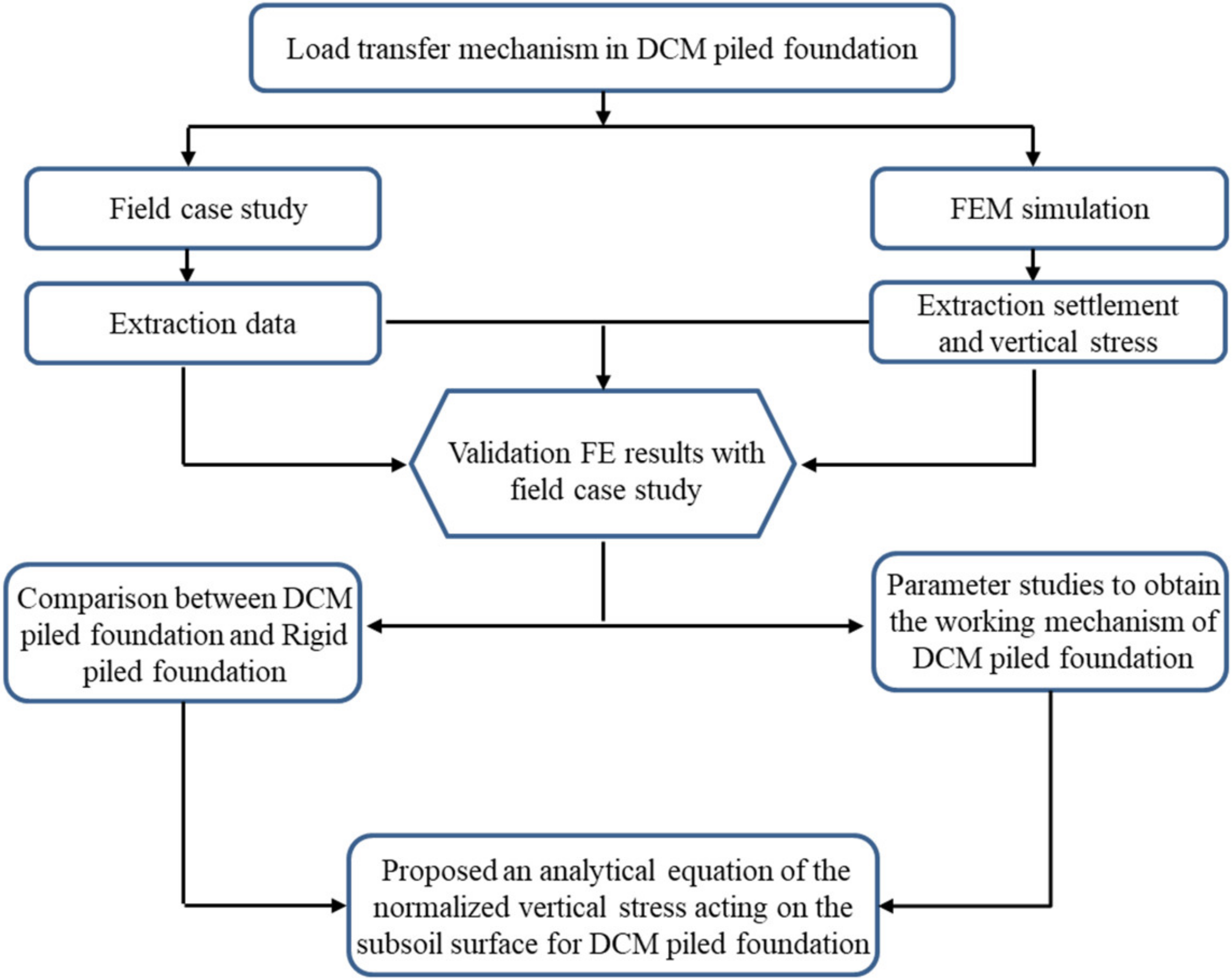
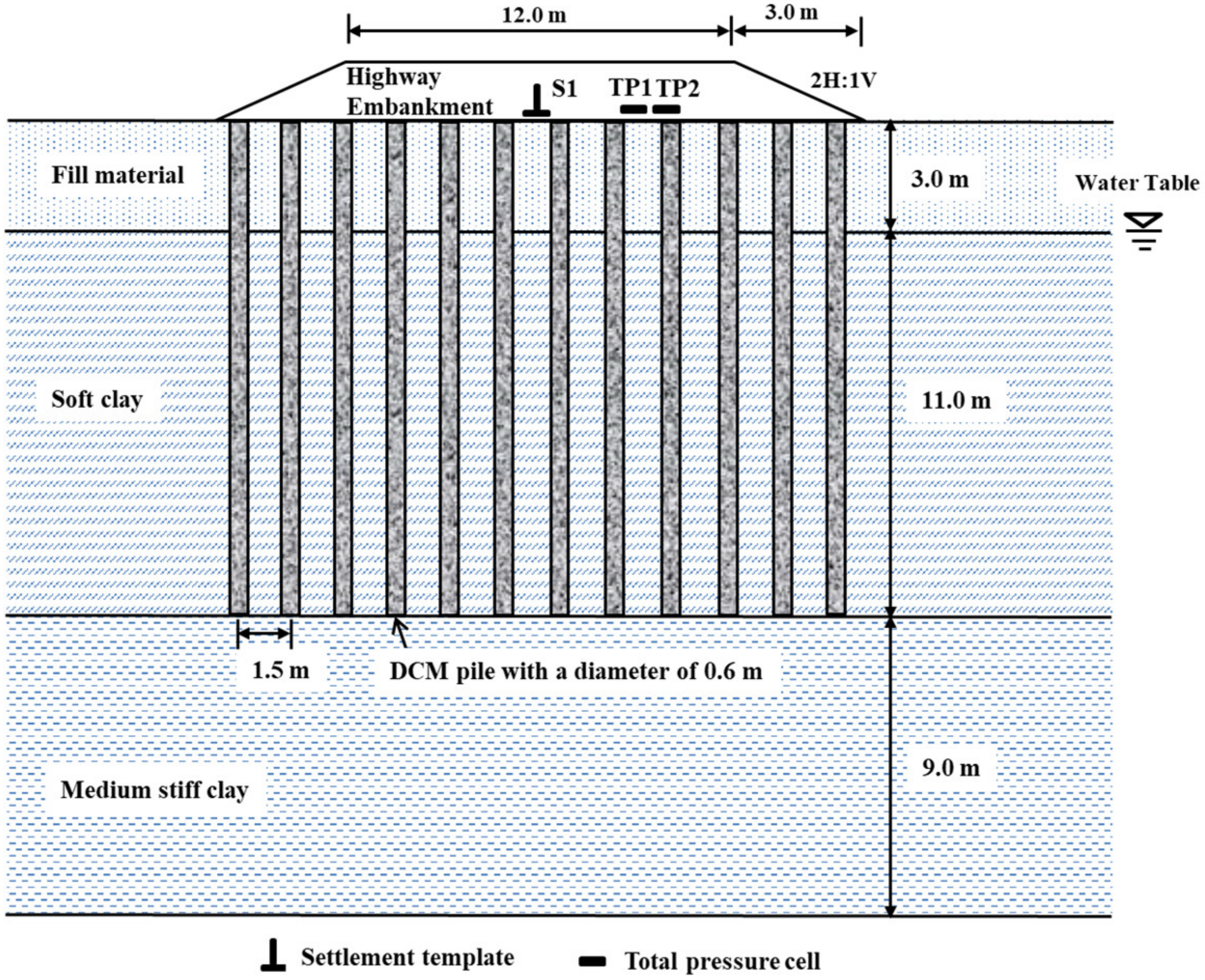
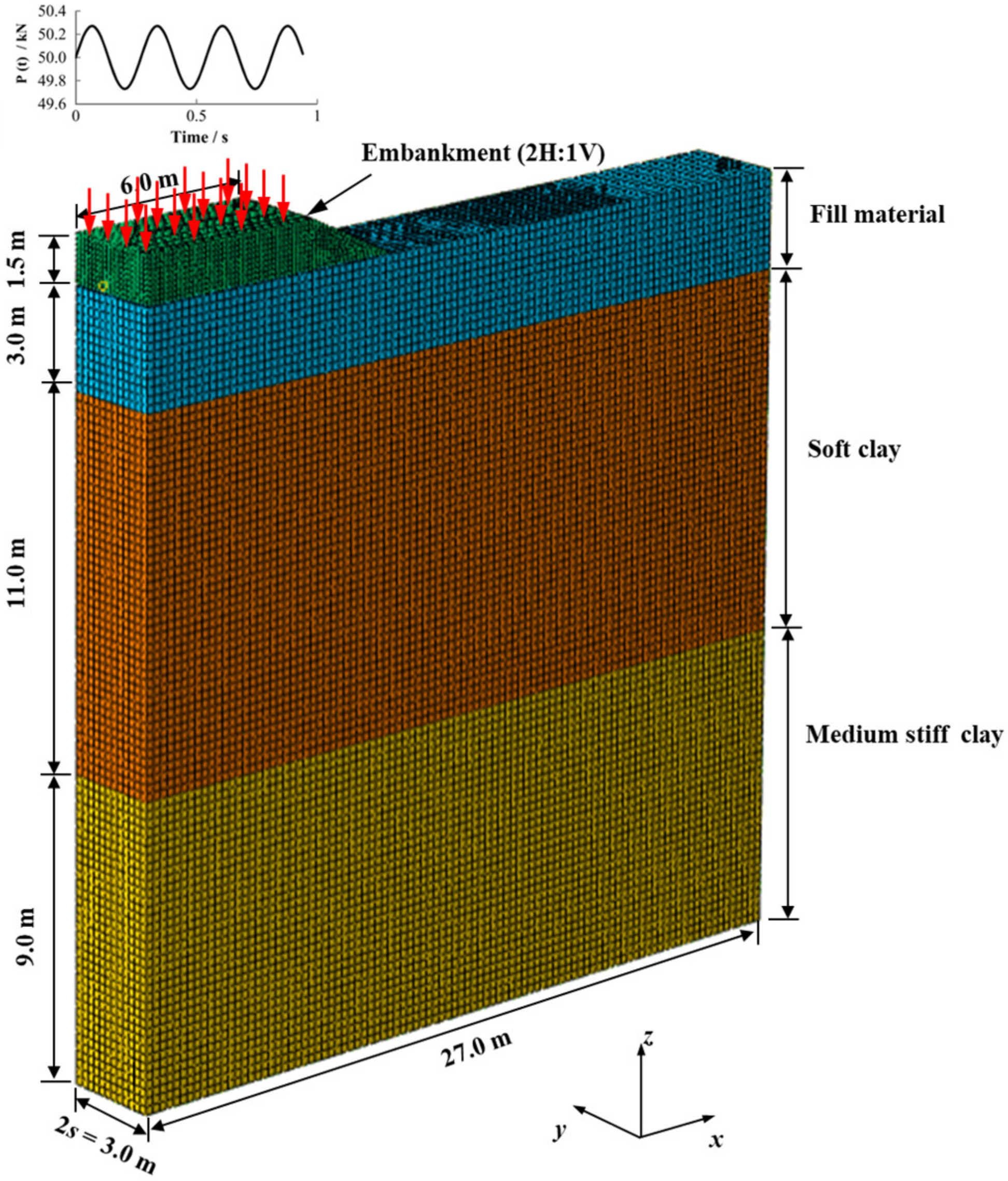

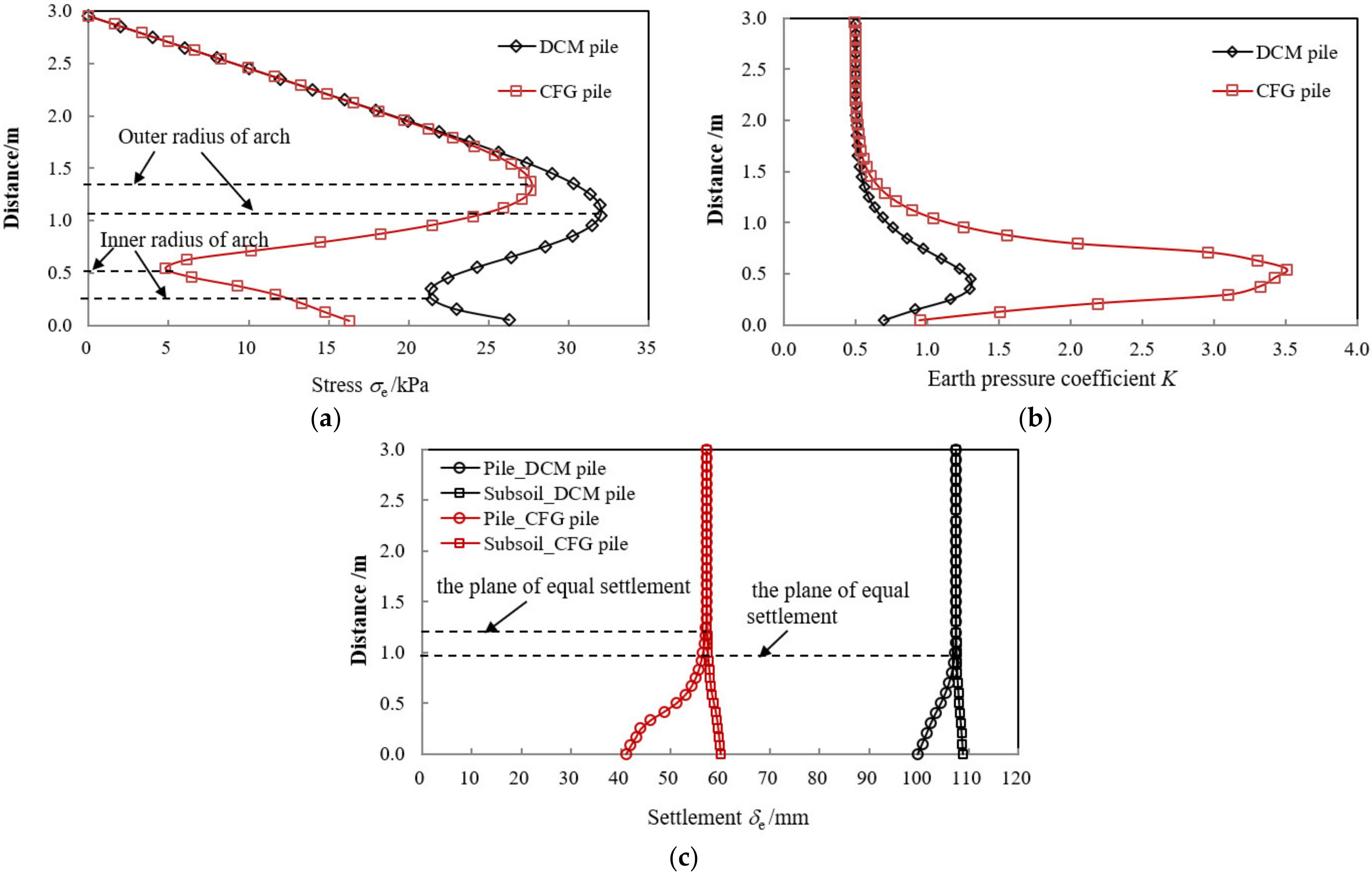
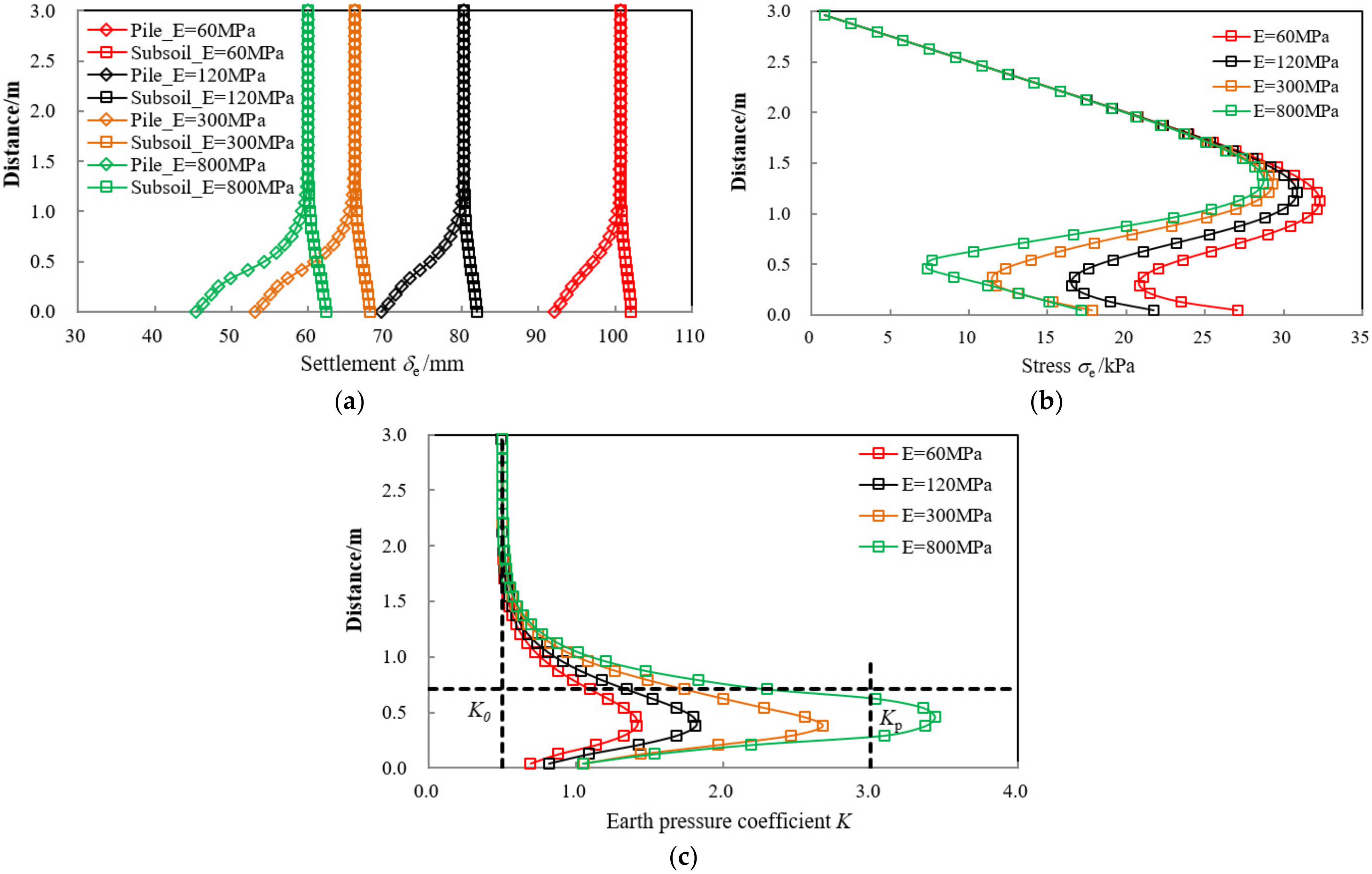

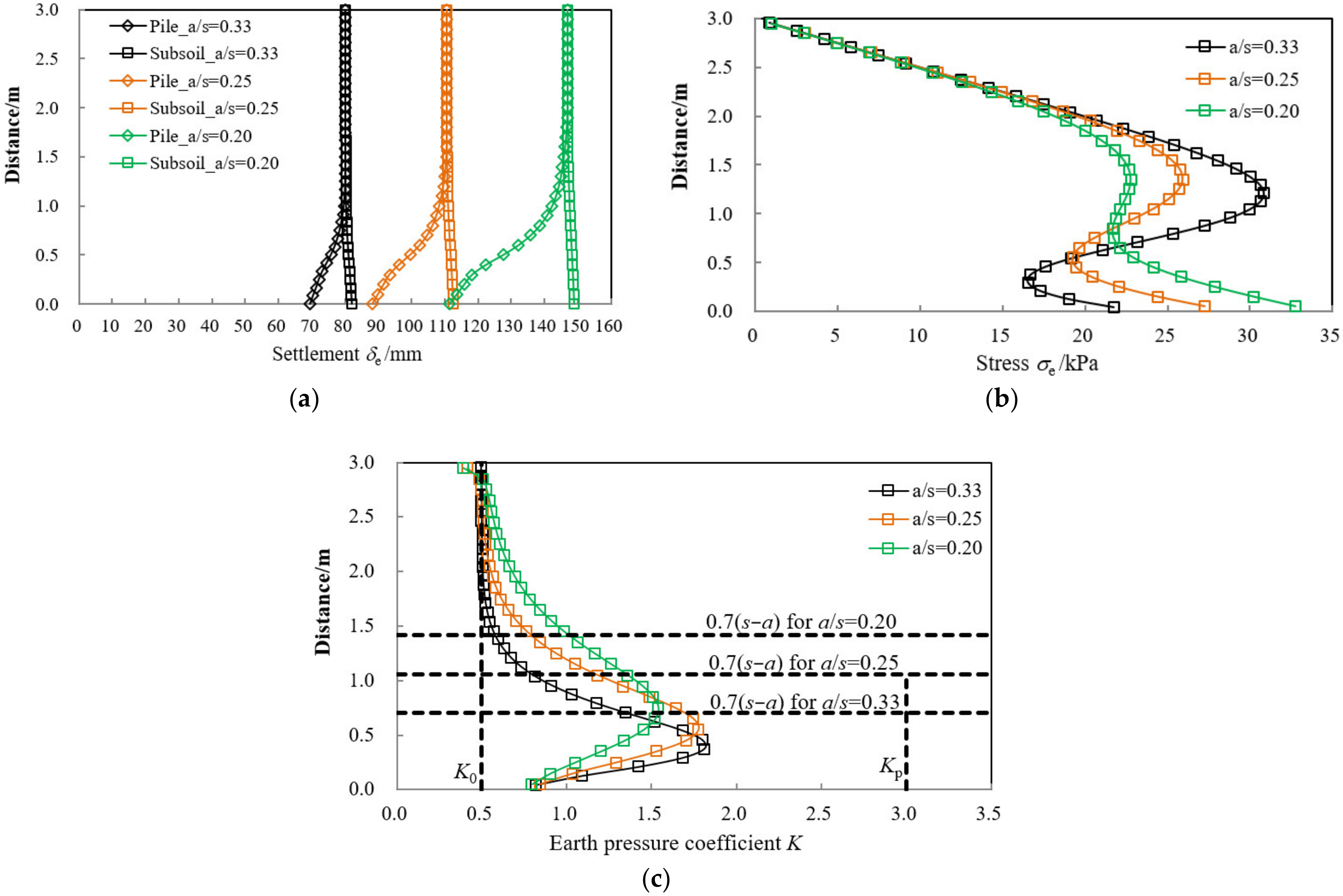
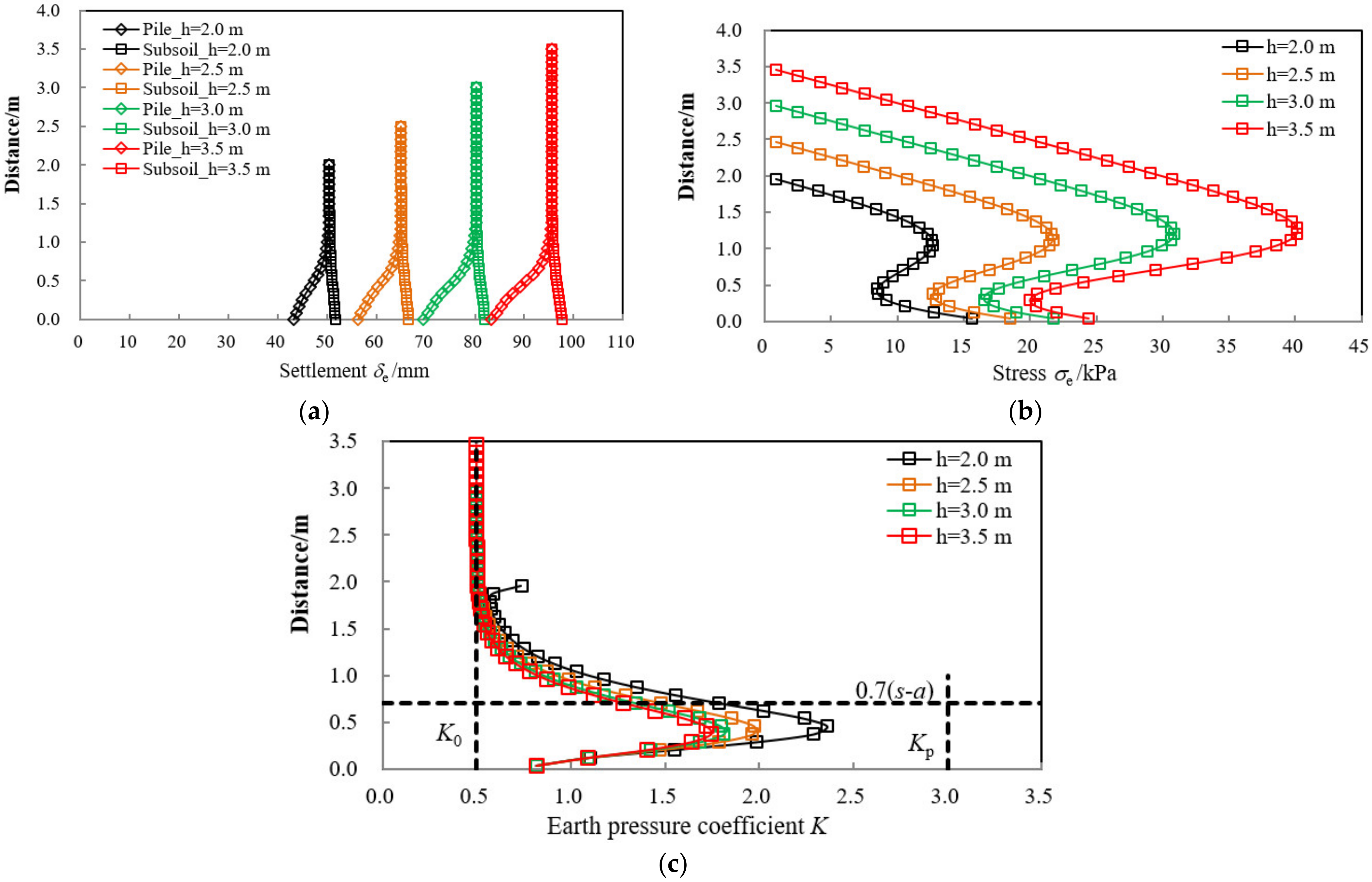
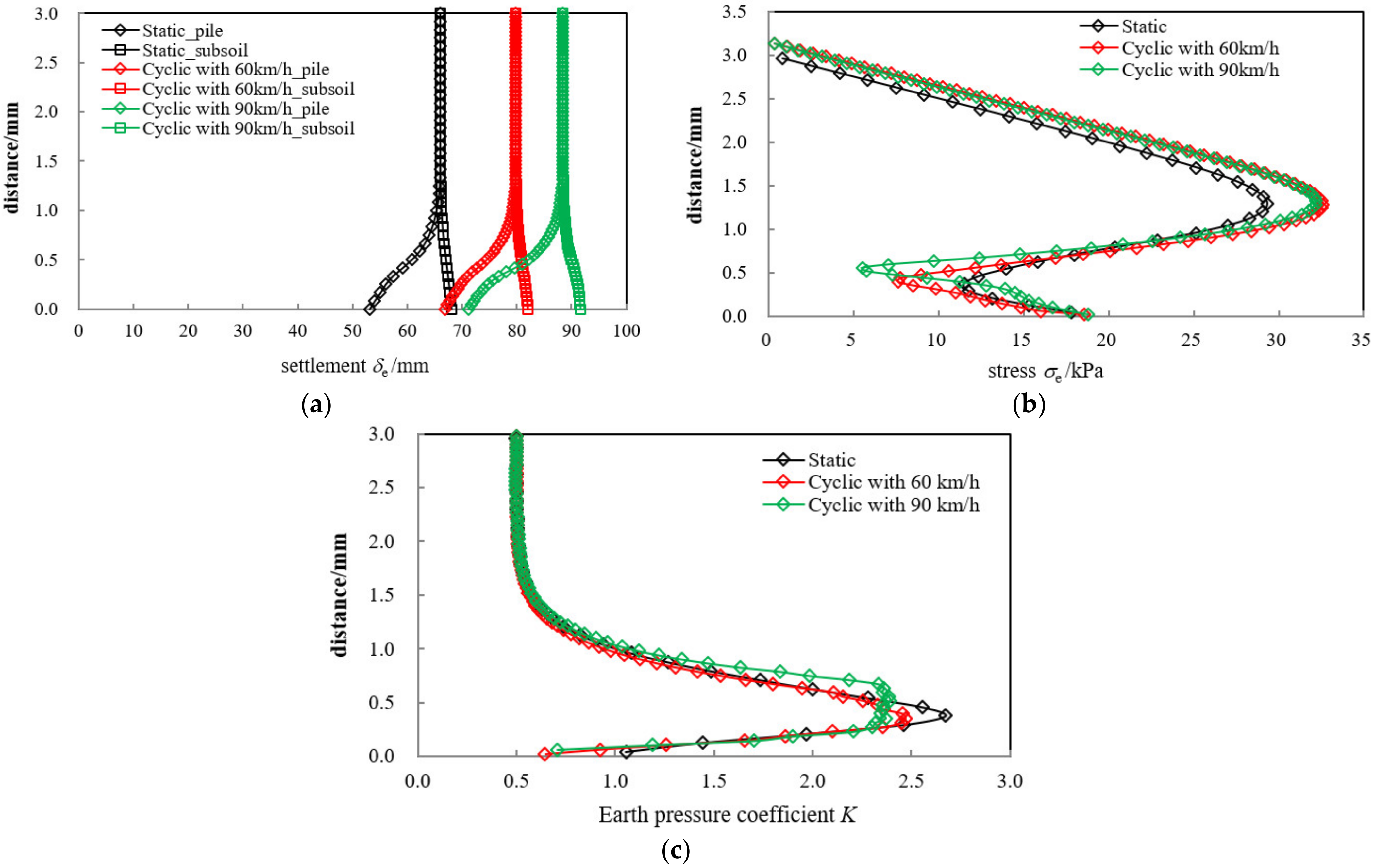
| Material | Unit Weight γ (kN/m3) | Elastic Modulus E (MPa) | Poisson’s Ratio ν | Cohesion c (kPa) | Friction Angle φ (Degree) | Permeability Coefficient k (m/d) |
|---|---|---|---|---|---|---|
| Embankment | 20 | 20 | 0.33 | 1 | 30 | -- |
| DCM pile | 15 | 80 | 0.33 | Cu = 450 | 0 | 5 × 10−4 |
| Fill Material | Soft Clay | Medium-Stiff Clay | |
|---|---|---|---|
| Unit weight, γ (kN/m3) | 20 | 14 | 16 |
| Compression index, λ | -- | 0.18 | 0.12 |
| Swelling index, κ | -- | 0.04 | 0.06 |
| Poisson’s ratio, ν | 0.30 | 0.35 | 0.15 |
| Cohesion, c (kPa) | 1 | 1 | 10 |
| Friction angle, φ (degree) | 32 | 23 | 25 |
| Permeability coefficient, k (m/d) | -- | 5 × 10−4 | 2.5 × 10−4 |
| Number | Pile Spacing s/m | Pile Cap Width a/m | Area Replacement Ratio as | Embankment Height h/m | Length of the DCM Pile L/m | Elastic Modulus of the DCM Pile Ep/MPa | Vehicle Speed v/km/h |
|---|---|---|---|---|---|---|---|
| 1 | 2.5 | 0.5 | 0.2 | 3.0 | 14 | 120 | 0 |
| 2 | 2.0 | 0.5 | 0.25 | 3.0 | 14 | 120 | 0 |
| 3 | 1.5 | 0.5 | 0.33 | 3.0 | 14 | 120 | 0 |
| 4 | 1.5 | 0.5 | 0.33 | 2.0 | 14 | 120 | 0 |
| 5 | 1.5 | 0.5 | 0.33 | 2.5 | 14 | 120 | 0 |
| 6 | 1.5 | 0.5 | 0.33 | 3.5 | 14 | 120 | 0 |
| 7 | 1.5 | 0.5 | 0.33 | 3.0 | 8 | 120 | 0 |
| 8 | 1.5 | 0.5 | 0.33 | 3.0 | 10 | 120 | 0 |
| 9 | 1.5 | 0.5 | 0.33 | 3.0 | 20 | 120 | 0 |
| 10 | 1.5 | 0.5 | 0.33 | 3.0 | 14 | 60 | 0 |
| 11 | 1.5 | 0.5 | 0.33 | 3.0 | 14 | 300 | 0 |
| 12 | 1.5 | 0.5 | 0.33 | 3.0 | 14 | 800 | 0 |
| 13 | 1.5 | 0.5 | 0.33 | 3.0 | 14 | 300 | 60 |
| 14 | 1.5 | 0.5 | 0.33 | 3.0 | 14 | 300 | 90 |
Disclaimer/Publisher’s Note: The statements, opinions and data contained in all publications are solely those of the individual author(s) and contributor(s) and not of MDPI and/or the editor(s). MDPI and/or the editor(s) disclaim responsibility for any injury to people or property resulting from any ideas, methods, instructions or products referred to in the content. |
© 2023 by the authors. Licensee MDPI, Basel, Switzerland. This article is an open access article distributed under the terms and conditions of the Creative Commons Attribution (CC BY) license (https://creativecommons.org/licenses/by/4.0/).
Share and Cite
Cui, X.; Cao, Y.; Jin, Y. Three-Dimensional Analysis of Load Transfer Mechanism for Deep Cement Mixing Piled Embankment under Static and Cyclic Load. Sustainability 2023, 15, 6532. https://doi.org/10.3390/su15086532
Cui X, Cao Y, Jin Y. Three-Dimensional Analysis of Load Transfer Mechanism for Deep Cement Mixing Piled Embankment under Static and Cyclic Load. Sustainability. 2023; 15(8):6532. https://doi.org/10.3390/su15086532
Chicago/Turabian StyleCui, Xiaoyan, Yajun Cao, and Yanli Jin. 2023. "Three-Dimensional Analysis of Load Transfer Mechanism for Deep Cement Mixing Piled Embankment under Static and Cyclic Load" Sustainability 15, no. 8: 6532. https://doi.org/10.3390/su15086532
APA StyleCui, X., Cao, Y., & Jin, Y. (2023). Three-Dimensional Analysis of Load Transfer Mechanism for Deep Cement Mixing Piled Embankment under Static and Cyclic Load. Sustainability, 15(8), 6532. https://doi.org/10.3390/su15086532






